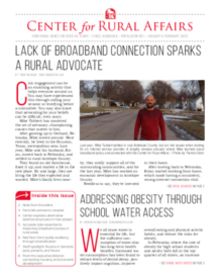Note from the editor
At the Center for Rural Affairs, all of our work ties into our set of values. One value in particular, “Genuine OPPORTUNITY for all to earn a living, raise a family, and prosper in a rural place” strikes a chord.
This is especially true when we focus on rural broadband. In our front page feature story, you’ll hear from a rural resident who had a tough time accessing this service, which is now a necessity of our lives. We use broadband for work, health care, education, leisure, and more.
Mike Tabbert’s story, unfortunately, is something we’ve heard over and over again. A story about someone who moves to a rural area and encounters this challenge. Mike just wants to live in a rural area and support his community.
We listened to Mike and to you. And, as our Policy Director Johnathan writes in his article on page 5, we are urging state lawmakers across the country to improve their broadband mapping. Because, right now, if one house in a Census block has internet, the internet service provider declares the entire Census block as served. That needs to be changed so that all rural citizens have an opportunity to live like they desire.
Do you have a rural issue, like broadband, that you want us to know about? Let us know at info@cfra.org.
Inside this issue
Lack of broadband connection sparks a rural advocate —Civic engagement can be an enriching activity that helps everyone around us. You may have experienced this through calling your senator or testifying before a committee. You may also know that advocating for your beliefs can be difficult, even scary. Mike Tabbert has mastered the art of advocacy; championing causes that matter to him.
Addressing obesity through school water access — We all know water is essential for life, but the sufficient consumption of water also has long-term health benefits. Increased water consumption has been found to reduce levels of dental decay, positively impact cognition, improve overall eating and physical activity habits, and reduce the risks for obesity.
From the desk of the executive director: Connecting housing and economic development — The Center has long focused on strategies to support economic vitality for small communities. Our work to assist small businesses, develop value-added agriculture, and improve policy all focus on creating widespread opportunity for people who live in rural areas. Increasingly, we see small town housing as an economic development issue.
Farm bill comments needed — At the Center for Rural Affairs, we are deeply engaged on the farm bill because of the enormous impact it has on rural communities. This is particularly true for conservation programs. Even though Congress passed a farm bill last year, there is still work to do in submitting comments to the U.S. Department of Agriculture.
Center explores alternative beehive structures in new project — The honey industry has experienced a drop in the number of bee hives in production in the past decade. This decline is a result of a number of pressures on bee health and beekeeper retirement. However, beekeeping as a supplemental farm income has increased in popularity over the past several years. Among the new beekeepers entering this industry are women, senior farmers, and those with disabilities. These newcomers are likely to struggle with the most commonly used beehive structure, the Langstroth hive, which can be large and heavy.
Accurate data essential to improving broadband access in rural areas — The Pew Research Center finds that only 63 percent of rural Americans have a broadband internet connection at home, and 24 percent of rural adults consider access to high speed internet a major problem in their local community. Recent policy developments are designed to address this. But, will they be enough?
Red Fern Farm builds resiliency through diversification — Tom Wahl and Kathy Dice, owners of Red Fern Farm, have built resiliency in their operation to overcome challenging weather. Nestled in a heavily wooded area just south of Grandview, Iowa, Red Fern Farm offers a unique experience for customers to harvest their own Iowa-grown fruits and nuts.
Staff spotlight: Rural is in Sandra’s past, present, and future — Sandra Renner has spent nearly five years focusing on a variety of work, all with one thing in common—assisting rural Nebraskans. Newly appointed as the Farm and Community Program director for the Center for Rural Affairs, Sandra began as a project associate within that program, and has since immersed herself in everything from outreach and promotion to grant writing to project management surrounding food systems work.


